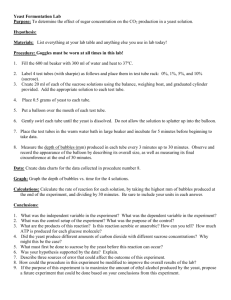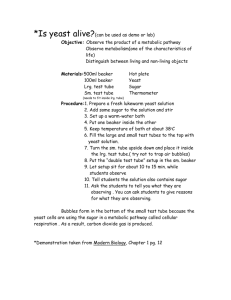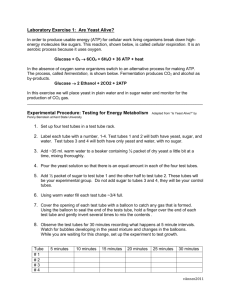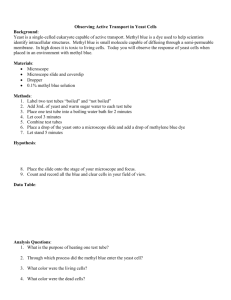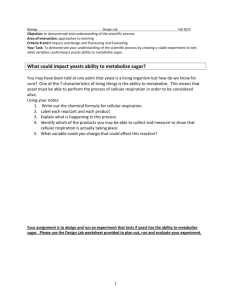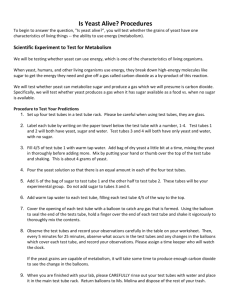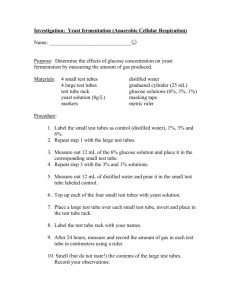Is Yeast Alive
advertisement
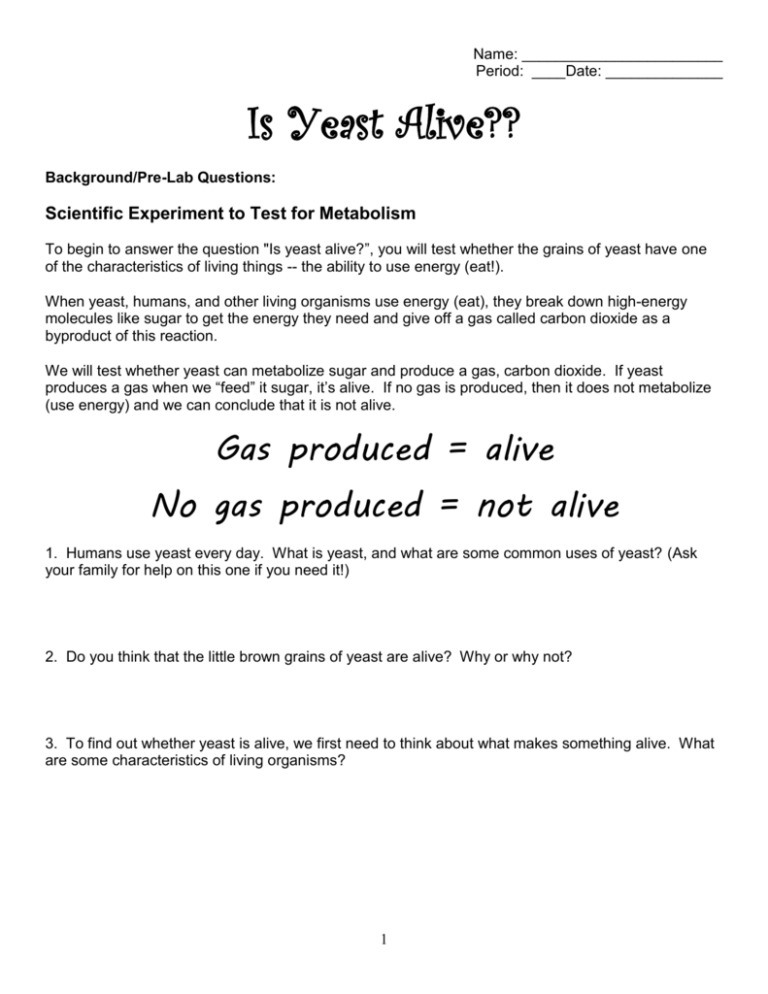
Name: ________________________ Period: ____Date: ______________ Is Yeast Alive?? Background/Pre-Lab Questions: Scientific Experiment to Test for Metabolism To begin to answer the question "Is yeast alive?”, you will test whether the grains of yeast have one of the characteristics of living things -- the ability to use energy (eat!). When yeast, humans, and other living organisms use energy (eat), they break down high-energy molecules like sugar to get the energy they need and give off a gas called carbon dioxide as a byproduct of this reaction. We will test whether yeast can metabolize sugar and produce a gas, carbon dioxide. If yeast produces a gas when we “feed” it sugar, it’s alive. If no gas is produced, then it does not metabolize (use energy) and we can conclude that it is not alive. Gas produced = alive No gas produced = not alive 1. Humans use yeast every day. What is yeast, and what are some common uses of yeast? (Ask your family for help on this one if you need it!) 2. Do you think that the little brown grains of yeast are alive? Why or why not? 3. To find out whether yeast is alive, we first need to think about what makes something alive. What are some characteristics of living organisms? 1 Is Yeast Alive? I. Purpose: The purpose of this experiment is to determine if yeast uses energy (metabolizes) and produces a gas when sugar is available. Research Question: Does yeast metabolize sugar and produce a gas? _______________ Predictions: A. Do you expect yeast to produce a gas when sugar is available? __________ B. Do you expect yeast to produce a gas when no sugar is available?________ II. Materials: 4 test tubes 1 test tube rack 1 sugar packet 1 stirring sticks ½ packet of yeast 4 balloons 1 beaker of warm water-105o-115o F III. Procedure: 1. Set up four test tubes in a test tube rack. 2. Test tubes 1 and 2 will both have yeast, sugar and water. Test tubes 3 and 4 will both have only yeast and water, with no sugar. 3. Fill a beaker with 40 mL of warm water--105o-115o F (41o – 46o C). Add the contents of one container of yeast the 40 mL beaker (or ½ packet of dry yeast) a LITTLE BIT AT A TIME, stirring the yeast in thoroughly before adding more. Stir by carefully swirling mixture with the wooden stick, being careful not to splash it out of the beaker. 4. Pour the yeast solution from the beaker into each of the four test tubes, filling each test tube evenly—about up to the RED LINE (~10 mL). 5. Add ½ packet of sugar to test tube 1 and the other half to test tube 2. These tubes will be your experimental group. Do not add sugar to tubes 3 and 4. 6. Cover the opening of test tubes 1 and 2 with a RED balloon and test tubes 3 and 4 with a BLUE balloon. Red=yeast + sugar, BLUE=yeast only. The balloons will catch any gas that is formed. Using the balloon to seal the end of the tests tube, hold a finger over the end of each test tube and shake it vigorously to thoroughly mix the contents. 7. Observe the test tubes and record your observations carefully in the table on the next page. Then, every 5 minutes for 25 minutes, observe what occurs in the test tubes and any changes in the balloons which cover each test tube, and record your observations. 9. If the yeast grains are capable of metabolism, it will take some time to produce enough carbon dioxide to see the change in the balloons. Be patient and make careful observations. While you are waiting for this change, record your observations every 5 minutes in the table. Between recording observations, work on answering the Lab Experiment Questions provided on the back of the yeast Observations and Questions Sheet. 10. After observation, remove the balloons from the test tubes. Rinse out the test tubes, beaker, and stirring stick in a sink. Clean up your lab area and return test tube racks, beakers, and other equipment as you found it. 2 IV. Data: A. Data Table – record descriptive observations of each test tube at 5-minute intervals in the boxes below 0 minutes 5 minutes 10 minutes 15 minutes 20 minutes Test tube 1 _______ Test tube 2 _______ Test tube 3 _______ Test tube 4 _______ B. Diagram: Draw a picture of the results of your tubes. Make sure you show if the balloons were inflated or not, and label your test tubes. Take your time. IT MUST BE IN COLOR!! 3 Lab Experiment Questions: Hypotheses: Write your hypotheses. Do you expect yeast to produce a gas when sugar is available? (Ex: If sugar is added to yeast, then the yeast will produce a gas.) ___________________________________________________________________________________ ___________________________________________________________________________________ Do you expect yeast to produce a gas when no sugar or other food is available? (Ex. If sugar is NOT added to yeast, then the yeast will still produce a gas.) ____________________________________________________________________________________ ____________________________________________________________________________________ 1. Discuss what you saw during the lab. What do you think it means? 2. Write down which parts of the experiment are the independent and dependent variables, and which part is the control group. 3. When you make bread, if you just mix flour, sugar and water, the dough does not rise, and the bread will be flat and hard. If you include yeast in the bread dough, then the dough rises and the bread is bigger and fluffier. Can you explain how the yeast helps the bread dough to rise? V. Conclusion: The purpose of this lab is ___________________________________________________________ ________________________________________________________________________________ The hypothesis was ______________________ because __________________________________ ________________________________________________________________________________ A possible source of error was that ____________________________________________________ ________________________________________________________________________________ To fix that error, next time __________________________________________________________ ________________________________________________________________________________ This relates to class because _________________________________________________________ ________________________________________________________________________________ The most interesting part of this lab was _______________________________________________ ________________________________________________________________________________ 4
